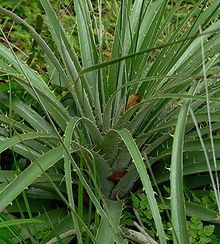Puya alpestris
| Puya alpestris | ||||||||||||
|---|---|---|---|---|---|---|---|---|---|---|---|---|

Habit and inflorescence with greenish, sterile tips of the partial inflorescences of Puya alpestris . |
||||||||||||
| Systematics | ||||||||||||
|
||||||||||||
| Scientific name | ||||||||||||
| Puya alpestris | ||||||||||||
| ( Poepp. ) Gay |
The Puya alpestris is a species of the bromeliad family (Bromeliaceae). The specific epithet alpestris for “Alps inhabiting” refers to the Andes for this species . It is native to dry hills in central and southern Chile and is one of the most southerly occurring species within the family. Puya alpestris is one of the few Puya species that are cultivated in some parks and gardens.
description
Puya alpestris grows as a xerophytic , perennial plant . A rosette of leaves is formed on a short stem. The tough, stiffly protruding, parallel- veined leaves run into a sharp point, are over 1 meter long and 2 to 2.5 centimeters wide. The leaf margin is reinforced with hooked, curved, approximately 0.5 cm long spines. The underside of the leaf is dense white scales.
Only after many years, an upright, relaxed, is rispiger total inflorescence formed, consisting of multiple traubigen composed part inflorescences. It contains many bright red bracts and many individual flowers. The tips of the partial inflorescences are sterile. The flower stalk is about 7 mm long. The hermaphrodite flower is threefold. The three greenish sepals are about 2.3 cm long and hairy or bald. The three metallic blue petals with blunt tips are about 4.5 cm long and spiral in as they fade. The six stamens have bright orange anthers . The flowers produce a lot of nectar. During the flowering period, one can observe hummingbirds and other birds pollinating the flowers ( ornithophilia ).
There are fruit capsules formed in each of many small, flight viable seeds are formed. After the seed and child development , the mother plant slowly dies.
Systematics
This species was first described by Eduard Friedrich Poeppig in 1833 in the Fragmentum Synopseos Plantarum Phanerogamum: 8 under the name Pourretia alpestris . Another synonym is Puya whytei Hook.f.
literature
- Werner Rauh : Bromeliads - Tillandsias and other bromeliads worthy of culture. Verlag Eugen Ulmer, Stuttgart 1990, ISBN 3-8001-6371-3
- Lyman B. Smith and Robert Jack Downs: Pitcairnioideae (Bromeliaceae). In: Flora Neotropica. No. 14.1: Hafner Press, New York, 1974, pp. 185-186.

